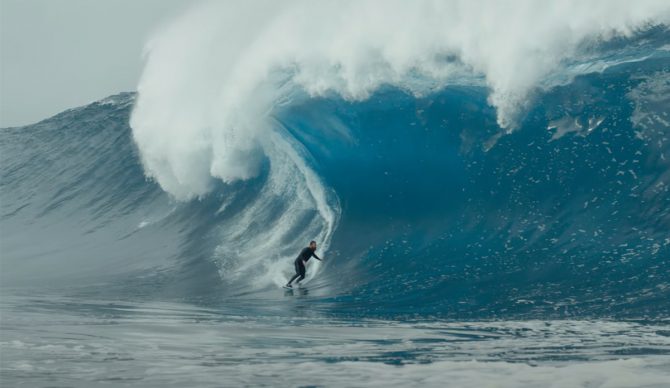How Crowds Fuel Innovation in Surfing


Kerby’s like most of us, he detests crowds. Not may surfers at these types of remote spots. Photo: Facing Monsters//Screenshot
In the HBO documentary series 100 Foot Wave, Buzzy Kerbox recounts the origins of tow surfing. “At some point,” he says, “all the North Shore breaks – they’re all just so crowded, it was just so hard to get the good wave. It’s like being at a ski resort and there’s just hundreds of people on every run, and then there’s just mountains in the back.” Buzzy’s comment made me think, is part of what has driven surfers to explore more and more extreme waves simply a response to the increasingly crowded lineups?
“The crowded line ups at all the North Shore breaks were definitely a big motivation for me to seek out the untapped resources of waves on the outer reefs.” Buzzy told me, “I was never really a big wave guy, but with towing and hanging with Laird we just kept going for bigger waves.”
Buzzy, Laird Hamilton and Darrick Doerner first took a Zodiac, and then Jet Skis out to catch those mountains waiting for them on the North shore of Oahu, and surfing hasn’t been the same since. With the advent of tow surfing, the height limit of a ridable wave went out the window, and the path was paved for the big wave aficionados we see today.
One of the men who has walked on that path is Kerby Brown. Kerby’s sort of an outlier, even in the world of big wave surfers. The waves he hunts aren’t the Nazare skyscrapers of 100 Foot Wave. Instead, Kerby goes for the mutant slabs of Western Australia: thick, punishing shelves of water that pound onto dry rock.
View this post on Instagram
At a screening of Facing Monsters, the documentary about Kerby’s lifelong obsession with these breaks, the man himself came for a Q and A session afterwards. At one point, he casually mentioned frustration with the lineup at the “regular” waves (most likely still a challenge for the average surfer). There it was again, the same sentiment. I pictured the origin story of the nascent legend, shoulder to shoulder at his home break, looking to the wild frontier for an escape from the lineup.
I reached out to Kerby and asked him how escaping crowds influenced his exploration of slabs in Western Australia. “The thought of going into the unknown has always really excited me, so going to these remote locations to chase swells with no one around was definitely part of the appeal,” he told me. “Doing the same thing repetitively, surfing well-known waves with people in the lineup never really satisfied me. I was always thinking, what else is out there? I love that there are no distractions, just being completely in the moment and trying to synchronize with mother nature.”
Since the accident that unfolded over the course of Facing Monsters, Kirby has taken a hiatus from slab hunting, so I asked him how it felt to be back in a lineup for a “normal” wave, after having the slabs to himself for so long. “I have never liked crowds but now more than ever has made me realize that I have no time for surfing anywhere with a crowded line up,” he wrote, “I won’t even entertain the idea if it’s crowded, I’d rather not go out. In saying that I’m lucky to live where I do. There’s generally not many people around and probably more sharks than humans.”
Avoiding crowds not only leads to innovations in terms of which waves surfers pursue, but also the boards themselves. Foil boards may get a side-eye in a surfing lineup, due to the fact they’re essentially a cross between a shortboard and a guillotine, but have been arguably the most radical development in board design since the addition of fins.
“The great thing about the foil is that it opens up opportunities” said Laird Hamilton of the technology he helped develop, “It opens up places that wouldn’t normally be looked at.” Laird being Laird, he was talking about finding a second break at Nazare, but a foil boarder can look to even a lowly ripple of windswell for a ride. They were originally invented by a bunch of big wave surfers screwing around with an Air Chair, but a significant part of the foil’s long-lasting appeal is that it finally offers a means of discovering new breaks in a world where it feels like everything that can be surfed is packed wall to wall.
Necessity is the mother of invention, as the saying goes. In the face of constraints, innovators begin to look outside the bounds of what has been previously possible, and take the rest of us forward with them. Though crowds are a maddening reality that only seems to get worse every year, at least we can look forward to the new inventions that they will inevitably inspire.
The post How Crowds Fuel Innovation in Surfing first appeared on The Inertia.
